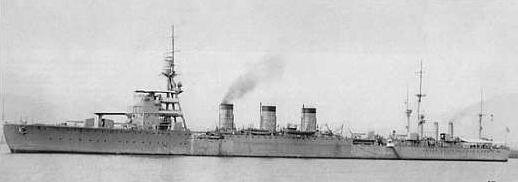Japanese “Natori Class” - World War II Era 1944-45 U.S. Carrier Pilot (Fitzgerald) Identification Poster





Japanese “Natori Class” - World War II Era 1944-45 U.S. Carrier Pilot (Fitzgerald) Identification Poster
Size: 8.5 x 11 inches
Title: “Natori Class”
This original World War II ship identification poster comes from the identification binder of a WWII Navy carrier pilot D. Fitzgerald. This poster was used by Fitzgerald and other U.S. carrier and Allied pilots to identify both Allied and Axis ships and aircraft. Combatants in war have consistently bombed and shot at their own ships and aircraft out of unfamiliarity of their shape and design. Thus, becoming familiar with the general layout of both Allied and enemy ships was a vital skill Allied intelligence sought to solve over the course of World War II. As a result of this, friendly fire intelligence resources such as ID posters, binders, and booklets were created to differentiate friend from foe. Whether you were a pilot flying combat missions or a sailor aboard any type of U.S. ship classes, the objective of all seagoing and air personnel was set to be able to recognize important aircraft, ships or ship types at a glance. Thus, familiarity with the details of naval and aircraft design illustrated in the following page proved of value to the student of ship identification.
Natori Class:
The six Nagara-class light cruisers (長良型軽巡洋艦, Nagaragata keijun'yōkan) were a class of six light cruisers built for and operated by the Imperial Japanese Navy. The Nagara-class cruisers proved useful in combat operations ranging from the Aleutian Islands to the Indian Ocean throughout World War II. Most served as flagships for destroyer or submarine squadrons, and were deployed for transport or local defense missions. Towards the end of the war, the surviving vessels were increasingly obsolete and were retained as second-line units.
Naval Aviation during WWII:
World War II saw the emergence of naval aviation as the decisive element in the war at sea. The principal users were Japan, United States (both with Pacific interests to protect) and Britain. Germany, the Soviet Union, France and Italy had a lesser involvement. Soviet Naval Aviation was mostly organised as land-based coastal defense force (apart from some scout floatplanes it consisted almost exclusively of land-based types also used by its air arms).
During the course of the war, seaborne aircraft were used in fleet actions at sea (Midway, Bismarck), strikes against naval units in port (Taranto, Pearl Harbor), support of ground forces (Okinawa, Allied invasion of Italy) and anti-submarine warfare (the Battle of the Atlantic). Carrier-based aircraft were specialised as dive bombers, torpedo bombers, and fighters. Surface-based aircraft such as the PBY Catalina helped finding submarines and surface fleets.
In World War II the aircraft carrier replaced the battleship as the most powerful naval offensive weapons system as battles between fleets were increasingly fought out of gun range by aircraft. The Japanese Yamato, the most powerful battleship ever built, was first turned back by light escort carrier aircraft and later sunk lacking its own air cover.
During the Doolittle Raid of 1942, 16 Army medium bombers were launched from the carrier Hornet on one-way missions to bomb Japan. All were lost to fuel exhaustion after bombing their targets and the experiment was not repeated. Smaller carriers were built in large numbers to escort slow cargo convoys or supplement fast carriers. Aircraft for observation or light raids were also carried by battleships and cruisers, while blimps were used to search for attack submarines.
Experience showed that there was a need for widespread use of aircraft which could not be met quickly enough by building new fleet aircraft carriers. This was particularly true in the North Atlantic, where convoys were highly vulnerable to U-boat attack. The British authorities used unorthodox, temporary, but effective means of giving air protection such as CAM ships and merchant aircraft carriers, merchant ships modified to carry a small number of aircraft. The solution to the problem were large numbers of mass-produced merchant hulls converted into escort aircraft carriers (also known as "jeep carriers"). These basic vessels, unsuited to fleet action by their capacity, speed and vulnerability, nevertheless provided air cover where it was needed.
The Royal Navy had observed the impact of naval aviation and, obliged to prioritize their use of resources, abandoned battleships as the mainstay of the fleet. HMS Vanguard was therefore the last British battleship and her sisters were cancelled. The United States had already instigated a large construction program (which was also cut short) but these large ships were mainly used as anti-aircraft batteries or for shore bombardment.
Other actions involving naval aviation included:
Battle of the Atlantic, aircraft carried by low-cost escort carriers were used for antisubmarine patrol, defense, and attack.
At the start of the Pacific War in 1941, Japanese carrier-based aircraft sank many US warships during the attack on Pearl Harbor and land-based aircraft sank two large British warships. Engagements between Japanese and American naval fleets were then conducted largely or entirely by aircraft - examples include the battles of Coral Sea, Midway, Bismarck Sea and Philippine Sea.
Battle of Leyte Gulf, with the first appearance of kamikazes, perhaps the largest naval battle in history. Japan's last carriers and pilots are deliberately sacrificed, a battleship is sunk by aircraft.
Operation Ten-Go demonstrated U.S. air supremacy in the Pacific theater by this stage in the war and the vulnerability of surface ships without air cover to aerial attack.